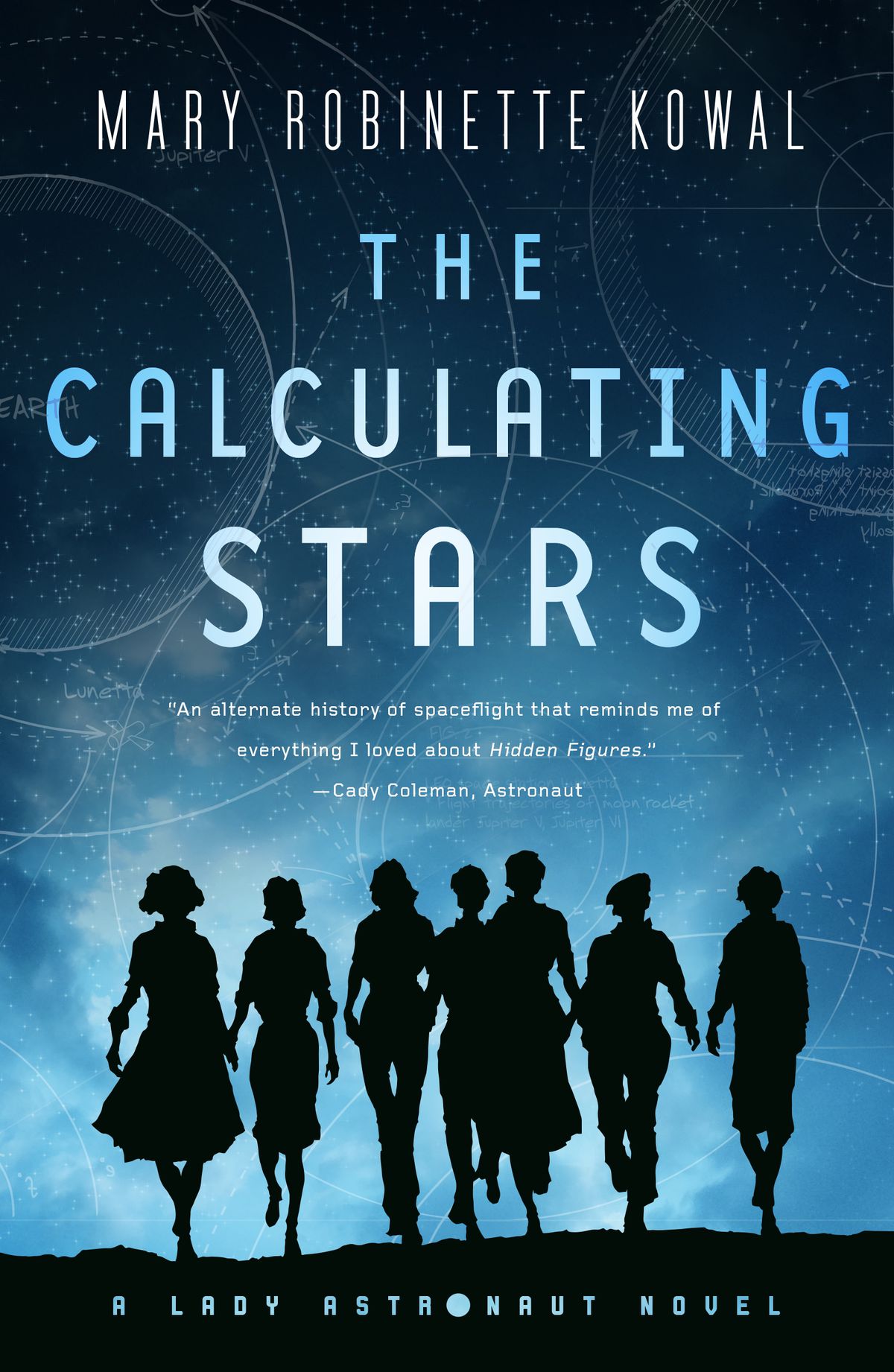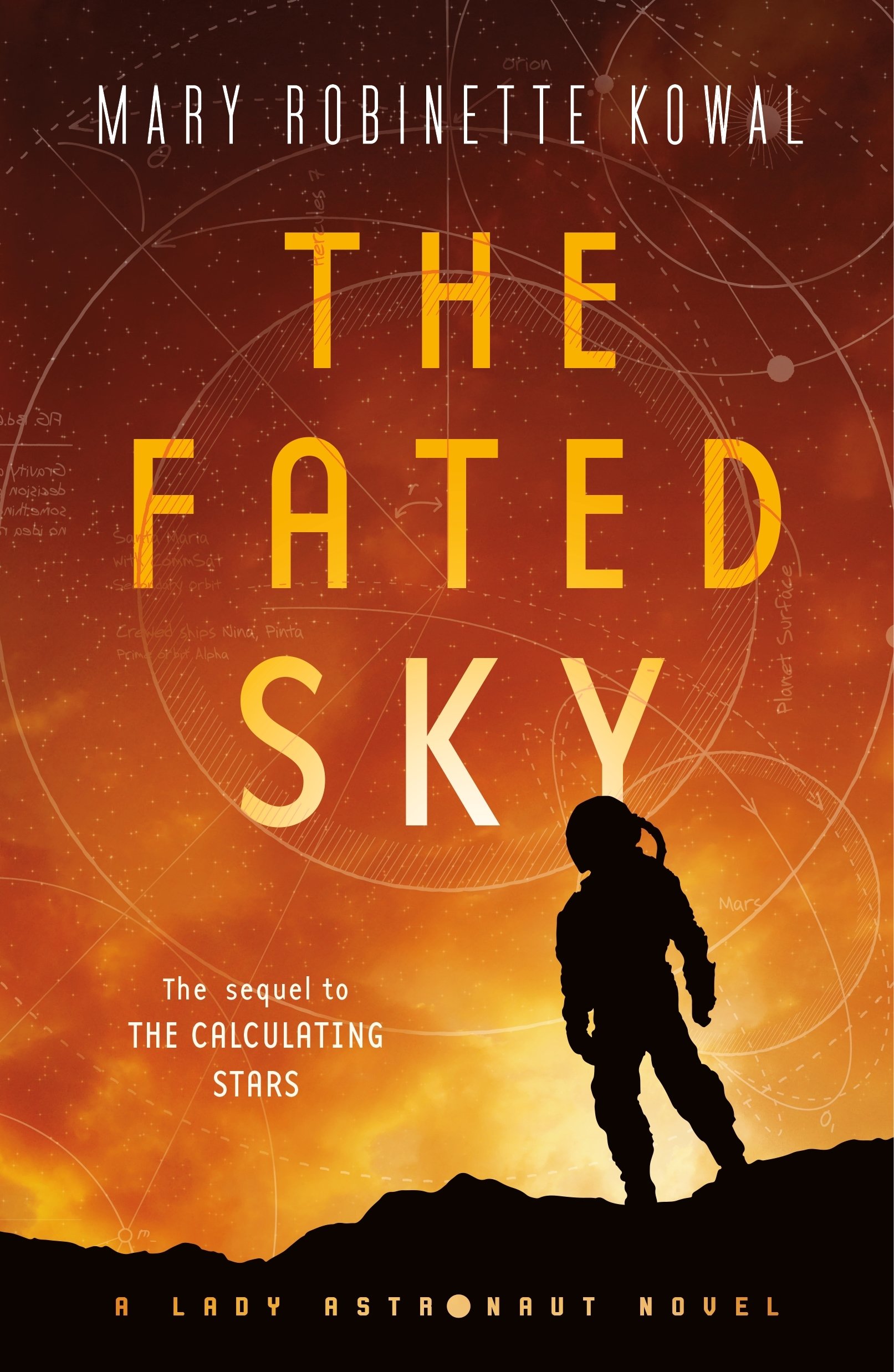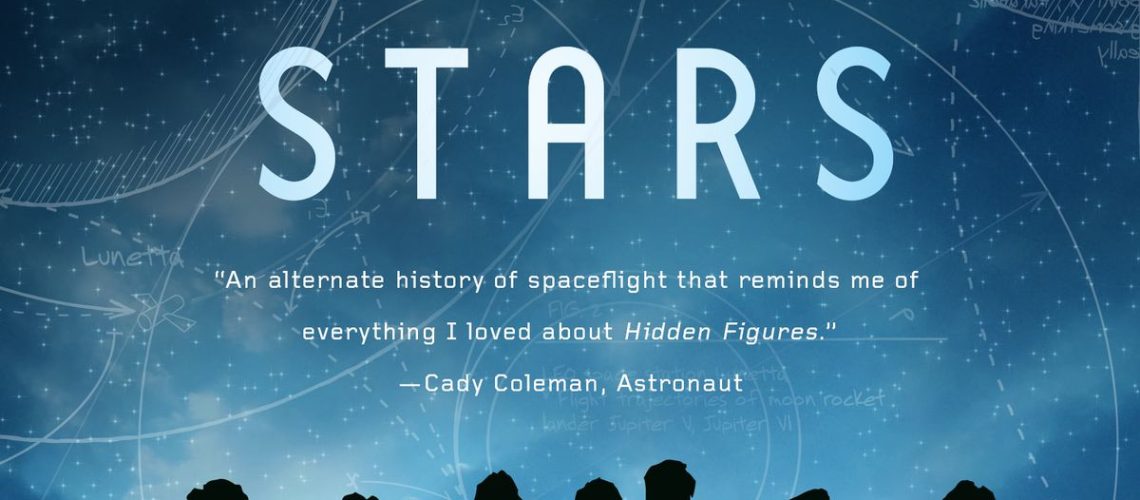Mary Robinette Kowal’s Lady Astronaut series began in 2012 when Audible.com published her novelette “The Lady Astronaut of Mars” within RIP-OFF, an original audiobook anthology. The Hugo-winning story subsequently saw print. Since then, Kowal has revisited the universe of that novelette with additional short stories, including “The Phobos Experience” in an issue of last summer’s The Magazine of Fantasy and Science Fiction. Additionally, she has also taken the story back to its “origins,” starting a series of Lady Astronaut novels with The Calculating Stars and The Fated Sky. The third novel in this series, The Relentless Moon, is due from Tor Books in 2020, meaning that you have plenty of time to catch up if you haven’t yet experienced this series of positivity and hope.
Combining alternate history with science fiction, the series tells a story both progressive and uplifting. At the core of the series lies the principle that if space is the future of humanity, then the process of humanity’s movement beyond the confines of Earth should involve all elements of that humanity. The stories are about the societal and technical challenges that face the characters involved in reaching that goal of colonizing alien worlds. Starting chronologically in 1952, Kowal takes elements of history and spins in an imagined catastrophe to set in motion an alternate timeline where the space program could be built differently, perhaps with more diversity. The establishment of that diverse representation proves as great of a challenge for humanity as do the physical threats against extra-planetary survival. The Lady Astronaut series depicts its characters overcoming these challenges, one step at a time.
 The Calculating Stars begins with a meteorite impact in 1952 that destroys most of the Eastern United States and initiates a climatic and ecological domino effect that will soon render Earth uninhabitable for human civilization. Barely surviving the meteorite impact are newlyweds, Drs. Elma and Nathaniel York. A mathematician and former Women Airforce Service Pilot (WASP) in the war, Elma pilots her husband to an area safe from the impact. She then accompanies him to speak with surviving government officials to advise on what the future will now hold for Earth and humanity. Nathaniel, a physicist and engineer, convincingly argues that the greatest chances for human survival lie in the establishment of Earth-like habitats elsewhere in our solar system, while there is still time. As employees at the National Advisory Committee for Aeronautics (the forerunner of our NASA), Elma and Nathaniel take key roles in making a space program a political reality to achieve this goal. While political powers quickly place Nathaniel into position as a lead engineer, they use Elma’s gender as a reason for overlooking her piloting skills when selecting astronaut candidates. Presented from Elma’s point of view, the novel follows her progress in garnering the recognition and opportunities that she deserves while overcoming the often-crippling anxiety that sabotages her in self-doubt.
The Calculating Stars begins with a meteorite impact in 1952 that destroys most of the Eastern United States and initiates a climatic and ecological domino effect that will soon render Earth uninhabitable for human civilization. Barely surviving the meteorite impact are newlyweds, Drs. Elma and Nathaniel York. A mathematician and former Women Airforce Service Pilot (WASP) in the war, Elma pilots her husband to an area safe from the impact. She then accompanies him to speak with surviving government officials to advise on what the future will now hold for Earth and humanity. Nathaniel, a physicist and engineer, convincingly argues that the greatest chances for human survival lie in the establishment of Earth-like habitats elsewhere in our solar system, while there is still time. As employees at the National Advisory Committee for Aeronautics (the forerunner of our NASA), Elma and Nathaniel take key roles in making a space program a political reality to achieve this goal. While political powers quickly place Nathaniel into position as a lead engineer, they use Elma’s gender as a reason for overlooking her piloting skills when selecting astronaut candidates. Presented from Elma’s point of view, the novel follows her progress in garnering the recognition and opportunities that she deserves while overcoming the often-crippling anxiety that sabotages her in self-doubt.
Political and social intrigues drive the plot of The Calculating Stars, but what gives those elements excitement and energy is the reader’s connection to Elma through her strengths and weaknesses. Both the story and her character are permeated with an optimistic hope, but with every few steps forward, obstacles force Elma down another step back. Elma’s hope is infectious for the reader, compelling one’s interest in seeing how she will transcend limitations.
Beyond being an exciting story of achievement, The Calculating Stars is a resounding positive message for inclusivity in STEM, and could be an inspiration for young readers. One of the historical characters who Kowal includes in the novel to fit with this theme is Don Herbert. You might know him as television’s Mr. Wizard, the host of STEM educational programs for decades until the arrival of his spiritual successor, Bill Nye. Noted for the inclusivity he practiced in his show, Mr. Wizard introduces Elma to society, a media image of her that soon becomes the “Lady Astronaut.” That media image generates positive press for the space program that politicians can’t ignore, leading to begrudging admittance of Elma into the program for the benefit of selling a public image. Elma’s success at breaking barriers against women is thus built in small steps, including advancements that seem to come for the “wrong” reasons. She faces internal ethical struggles on how to deal with these issues. Should she adapt this “Lady Astronaut” role or refuse to play along in the game? Ultimately, she realizes that the privileges she does get to enjoy – even if not formed in the way she would like – should be used to their fullest advantage to realize the change she envisions, opening the space program to all.
This includes Elma’s advocating for a space program that incorporates international partnerships and also becomes open for all races. Kowal does a good job tackling racial issues and historical details of segregation in the US by having Elma reflect on the privilege she has as an affluent white woman, balanced with the hurdles she faces as a Jewish woman who feels pressured to hide mental health issues. I have witnessed many try to negate the experiences of others by bringing up their own personal hardships without really listening to the other or recognizing disparity in relative privilege/adversity. Elma offers an important alternative in handling these issues and interactions by placing the focus on the respect of individuals and the affirmation of their perspective. However, it’s important to note this also comes from my own personal white male perspective and that others may view this differently.
 All of these issues continue to dominate the themes of The Fated Sky, which begins roughly a decade after The Calculating Stars. The space program has evolved into the International Aerospace Coalition (IAC) and has established a colony on the moon where Elma continues to work as the famous “Lady Astronaut.” However, the first mission to expand colonization to Mars is being planned, and none of the astronauts slated for the mission are women. Again, this second novel continues to remind us that true inclusion does not happen overnight and that it can be a continuing battle.
All of these issues continue to dominate the themes of The Fated Sky, which begins roughly a decade after The Calculating Stars. The space program has evolved into the International Aerospace Coalition (IAC) and has established a colony on the moon where Elma continues to work as the famous “Lady Astronaut.” However, the first mission to expand colonization to Mars is being planned, and none of the astronauts slated for the mission are women. Again, this second novel continues to remind us that true inclusion does not happen overnight and that it can be a continuing battle.
The second novel presents an expanded cast of characters, new technical concerns arising from existing on the moon and pushing on to Mars, and new plot developments. The latter arise in part from conflicting national interests and cultural biases within the IAC. Additionally, terrorist acts by a growing movement opposed to humans leaving Earth threatens IAC projects, a plot element perhaps in homage to Sagan’s Contact. While dealing with these threats, the novel again shows how characters must work to overcome individual challenges. While Elma still faces hers, more emphasis now falls on the struggles of secondary characters, including a white male that has served since the first book as a major antagonist for Elma. Kowal does a phenomenal job at developing him to show why he acts the way he does, illustrating that even those with exceptional privilege might still be able to relate to the prejudices of society.
Throughout both novels Nathaniel serves as a major support system for Elma, a conscientious and understanding voice that both guides and reinforces. Elma is the ultimate deciding factor in her choices and the agent of her success, but her relationship with her husband and their mutual trust and sacrifice drive things through a collaboration. Along with obtaining proper diagnosis and medication, their relationship is a key part to Elma’s overcoming anxiety and stepping into her professional roles in the space program. It adds a nice touch of romantic depth to the story in a way that many other genre novels fail to consider.
Elma also uses her fascination with mathematics as a tool for working through moments of mental crisis, calling upon the pure calm of numbers to stave off panic. From my perspective Kowal also handles this element appropriately – and in a realistic and respectful fashion. I have often seen fellow scientists deal with moments of panic by focusing on details of their specialty, finding calm in some type of order. Spiritual exercises of many religions focus on prayers or mantras. Personally, I go to classical music – particularly the structure of Bach’s work – to accomplish the same in moments of panic. For Elma, it makes perfect sense that she would turn to the comforts of numbers and her inherent talent with them.
Beyond serving a therapeutic role for her character, mathematical and other technical details in the novels provide a healthy amount of “hard science fiction” to the novels. For scenes featuring technically specific language (including pilot jargon), Kowal had relevant experts provide key pieces of dialogue, and this attention to detail shows in how easily such scenes flow for readers. I am not particularly into these kinds of details, and I often find an author’s insertion of them into a novel to be distracting. In this case, however, they worked well, perhaps because all of these technical details also folded into key aspects of character – whether Elma’s or another’s.
Even though I did enjoy both novels and appreciated the positivity and progressive themes, I also recognize that there is a fine balance in handling these things in a way that works and in a way that becomes too unsubtle. At times, Kowal’s Lady Astronaut novels border on becoming too heavy handed or “perfect” for me. The events that transpire to give a political green light to the mission of colonizing another world seemed too easy, largely born from the happenstance of who is left in power after the initial meteor strike disaster. On the smaller scale of things, Nathaniel embodies an idealized spouse, a perfect specimen of sacrifice, support, and romance. The lack of any discernible faults in his character makes him – and his relationship with Elma – seem implausible.
Yet, I also recognize that this aversion to things working out so well, or to characters talking so overtly and thoroughly about principals of inclusivity stems from my own pessimism, a lack of hope that these books are precisely out to combat. We become conditioned so much by our perceptions of how the world works, or how people interact, that it sometimes becomes hard to accept that other realities and behaviors might be achievable. Writing speculative fiction about hope and cooperation between different groups of people becomes a difficult balance between presenting a viably brighter future without denying the seemingly insurmountable obstacles that stand in its way. Kowal presents examples – like the relationship between Elma and Nathan – in which people actually communicate with one another effectively to gain understanding of their different points-of-views, to appreciate one another’s opinions and personal struggles.
Unfortunately, showing such an optimistic and functional future (or alternate past) for human interaction can easily invite criticism that characters or plots have become unbelievable. But really, why is this less believable than the darkest of dystopias? Is it not beneficial to paint a picture of what could actually occur to make things better? Is that not what so many claim the “Golden Age of SF” set out to do? The Lady Astronaut novels have forced me to recognize my difficulty with handling such hopeful visions and to reflect on becoming more receptive to them.
At the end of last year, Edward M. Lerner wrote an Analog editorial entitled “Dystopic? Or Myopic?”, bemoaning the prevalence and popularity of stories filled with “hopelessness and misery” in science fiction. I hope to one day fully address on Skiffy & Fanty what I both appreciated about and found problematic with that editorial. But it bears mentioning now that the Lady Astronaut novels are prime examples of genre fiction that achieve exactly what Lerner asks for – and which he seemingly can’t find. The Calculating Stars begins with a meteorite impact that could have ushered in dystopic visions of SF grimdark. Instead, Kowal uses that destruction and the subsequent challenges to demonstrate a pathway where humanity can rise above despair and actually build accomplishments. Those accomplishments will still be hard fought, and will come with costs, but they will also result in overall advancement. Just as the series envisions a way that humanity overcomes disaster to reach the stars, it also demonstrates the exact same processes of achieving success despite adversity on the level of its individual characters.
Perhaps we should have more fiction like that. But in the meantime, critics of dystopia or those who merely want a break away from it should consider giving the Lady Astronaut novels a read. They could also share them with a teenager that might be excited to discover that STEM should have a place for all, and that we could even envision how a world that makes that a reality might look.
The Calculating Stars and The Fated Sky are available via Tor Books or wherever good books are sold.







